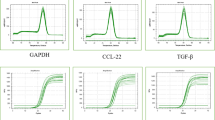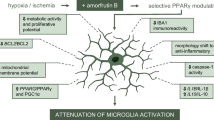Abstract
Pyroptosis is a new type of programmed cell death, which induces a strong pro-inflammatory reaction. However, the mechanism of pyroptosis after brain ischemia/reperfusion (I/R) and the interaction between different neural cell types are still unclear. This study comprehensively explored the mechanisms and interactions of microglial and neuronal pyroptosisin the simulated I/R environment in vitro. The BV2 (as microglial) and HT22(as neuronal) cells were treated by oxygen–glucose deprivation/reoxygenation (OGD/R). Both BV2 and HT22 cells underwent pyroptosis after OGD/R, and the pyroptosis occurred at earlier time point in HT22than that of BV2. Caspase-11 and Gasdermin E expression in BV2 and HT22 cells did not change significantly after OGD/R. Inhibition of caspase-1 or GSDMD activity, or down-regulation of GSDMD expression, alleviated pyroptosis in both BV2 and HT22 cells after OGD/R. Transwell studies further showed that OGD/R-treated HT22 or BV2 cells aggravated pyroptosis of adjacent non-OGD/R-treated cells, which could be relieved by inhibition of caspase-1 or GSDMD. These results suggested that OGD/R induces pyroptosis of microglia and neuronal cells and aggravates cell injury via activation of caspase-1/GSDMD signaling pathway. Our findings indicated that caspase-1 and GSDMD may be therapeutic targets after cerebral I/R.








Similar content being viewed by others
Data Availability
Datasets analyzed during the current study are available from the corresponding author on reasonable request.
References
Hu X, De Silva TM, Chen J, Faraci FM (2017) Cerebral vascular disease and neurovascular injury in ischemic stroke. Circ Res 120:449–471. https://doi.org/10.1161/CIRCRESAHA.116.308427
Powers WJ, Rabinstein AA, Ackerson T, Adeoye OM, Bambakidis NC, Becker K et al (2018) 2018 Guidelines for the early management of patients with acute ischemic stroke: a guideline for healthcare professionals from the American Heart Association/American Stroke Association. Stroke 49:e46–e110. https://doi.org/10.1161/STR.0000000000000158
Alberts MJ (2017) Stroke treatment with intravenous tissue-type plasminogen activator: more proof that time is brain. Circulation 135:140–142. https://doi.org/10.1161/CIRCULATIONAHA.116.025724
Mizuma A, Yenari MA (2017) Anti-inflammatory targets for the treatment of reperfusion injury in stroke. Front Neurol 8:467. https://doi.org/10.3389/fneur.2017.00467
Hossmann KA (2012) The two pathophysiologies of focal brain ischemia: implications for translational stroke research. J Cereb Blood Flow Metab 32:1310–1316. https://doi.org/10.1038/jcbfm.2011.186
Voet S, Srinivasan S, Lamkanfi M, van Loo G (2019) Inflammasomes in neuroinflammatory and neurodegenerative diseases. EMBO Mol Med. https://doi.org/10.15252/emmm.201810248
Walsh JG, Muruve DA, Power C (2014) Inflammasomes in the CNS. Nat Rev Neurosci 15:84–97. https://doi.org/10.1038/nrn3638
Lampron A, Elali A, Rivest S (2013) Innate immunity in the CNS: redefining the relationship between the CNS and its environment. Neuron 78:214–232. https://doi.org/10.1016/j.neuron.2013.04.005
Liddelow SA, Guttenplan KA, Clarke LE, Bennett FC, Bohlen CJ, Schirmer L et al (2017) Neurotoxic reactive astrocytes are induced by activated microglia. Nature 541:481–487. https://doi.org/10.1038/nature21029
Bergsbaken T, Fink SL, Cookson BT (2009) Pyroptosis: host cell death and inflammation. Nat Rev Microbiol 7:99–109. https://doi.org/10.1038/nrmicro2070
Dong Z, Pan K, Pan J, Peng Q, Wang Y (2018) The possibility and molecular mechanisms of cell pyroptosis after cerebral ischemia. Neurosci Bull 34:1131–1136. https://doi.org/10.1007/s12264-018-0294-7
Adamczak SE, de Rivero Vaccari JP, Dale G, Brand FJ 3rd, Nonner D, Bullock MR et al (2014) Pyroptotic neuronal cell death mediated by the AIM2 inflammasome. J Cereb Blood Flow Metab 34:621–629. https://doi.org/10.1038/jcbfm.2013.236
Galluzzi L, Vitale I, Abrams JM, Alnemri ES, Baehrecke EH, Blagosklonny MV et al (2012) Molecular definitions of cell death subroutines: recommendations of the Nomenclature Committee on Cell Death 2012. Cell Death Differ 19:107–120. https://doi.org/10.1038/cdd.2011.96
Miao EA, Rajan JV, Aderem A (2011) Caspase-1-induced pyroptotic cell death. Immunol Rev 243:206–214. https://doi.org/10.1111/j.1600-065X.2011.01044.x
Shi J, Zhao Y, Wang K, Shi X, Wang Y, Huang H et al (2015) Cleavage of GSDMD by inflammatory caspases determines pyroptotic cell death. Nature 526:660–665. https://doi.org/10.1038/nature15514
Kayagaki N, Stowe IB, Lee BL, O’Rourke K, Anderson K, Warming S et al (2015) Caspase-11 cleaves gasdermin D for non-canonical inflammasome signalling. Nature 526:666–671. https://doi.org/10.1038/nature15541
He WT, Wan H, Hu L, Chen P, Wang X, Huang Z et al (2015) Gasdermin D is an executor of pyroptosis and required for interleukin-1beta secretion. Cell Res 25:1285–1298. https://doi.org/10.1038/cr.2015.139
Rogers C, Fernandes-Alnemri T, Mayes L, Alnemri D, Cingolani G, Alnemri ES (2017) Cleavage of DFNA5 by caspase-3 during apoptosis mediates progression to secondary necrotic/pyroptotic cell death. Nat Commun 8:14128. https://doi.org/10.1038/ncomms14128
Wang Y, Gao W, Shi X, Ding J, Liu W, He H et al (2017) Chemotherapy drugs induce pyroptosis through caspase-3 cleavage of a gasdermin. Nature 547:99–103. https://doi.org/10.1038/nature22393
Wang Y, Yin B, Li D, Wang G, Han X, Sun X (2018) GSDME mediates caspase-3-dependent pyroptosis in gastric cancer. Biochem Biophys Res Commun 495:1418–1425. https://doi.org/10.1016/j.bbrc.2017.11.156
Poh L, Kang SW, Baik SH, Ng GYQ, She DT, Balaganapathy P et al (2019) Evidence that NLRC4 inflammasome mediates apoptotic and pyroptotic microglial death following ischemic stroke. Brain Behav Immun 75:34–47. https://doi.org/10.1016/j.bbi.2018.09.001
Zhang D, Qian J, Zhang P, Li H, Shen H, Li X et al (2019) Gasdermin D serves as a key executioner of pyroptosis in experimental cerebral ischemia and reperfusion model both in vivo and in vitro. J Neurosci Res 97:645–660. https://doi.org/10.1002/jnr.24385
Tang M, Li X, Liu P, Wang J, He F, Zhu X (2018) Bradykinin B2 receptors play a neuroprotective role in Hypoxia/reoxygenation injury related to pyroptosis pathway. Curr Neurovasc Res 15:138–144. https://doi.org/10.2174/1567202615666180528073141
Rathkey JK, Zhao J, Liu Z, Chen Y, Yang J, Kondolf HC et al (2018) Chemical disruption of the pyroptotic pore-forming protein gasdermin D inhibits inflammatory cell death and sepsis. Sci Immunol. https://doi.org/10.1126/sciimmunol.aat2738
Wang Z, Meng S, Cao L, Chen Y, Zuo Z, Peng S (2018) Critical role of NLRP3-caspase-1 pathway in age-dependent isoflurane-induced microglial inflammatory response and cognitive impairment. J Neuroinflammation 15:109–120. https://doi.org/10.1186/s12974-018-1137-1
Kaushal V, Schlichter LC (2008) Mechanisms of microglia-mediated neurotoxicity in a new model of the stroke penumbra. J Neurosci 28:2221–2230. https://doi.org/10.1523/JNEUROSCI.5643-07.2008
Ding J, Wang K, Liu W, She Y, Sun Q, Shi J et al (2016) Pore-forming activity and structural autoinhibition of the gasdermin family. Nature 535:111–116. https://doi.org/10.1038/nature18590
Chen X, He WT, Hu L, Li J, Fang Y, Wang X et al (2016) Pyroptosis is driven by non-selective gasdermin-D pore and its morphology is different from MLKL channel-mediated necroptosis. Cell Res 26:1007–1020. https://doi.org/10.1038/cr.2016.100
Liu X, Zhang Z, Ruan J, Pan Y, Magupalli VG, Wu H et al (2016) Inflammasome-activated gasdermin D causes pyroptosis by forming membrane pores. Nature 535:153–158. https://doi.org/10.1038/nature18629
Sborgi L, Ruhl S, Mulvihill E, Pipercevic J, Heilig R, Stahlberg H et al (2016) GSDMD membrane pore formation constitutes the mechanism of pyroptotic cell death. EMBO J 35:1766–1778. https://doi.org/10.15252/embj.201694696
Brown GC, Vilalta A (2015) How microglia kill neurons. Brain Res 1628:288–297. https://doi.org/10.1016/j.brainres.2015.08.031
von Bernhardi R, Eugenin-von Bernhardi J, Flores B, Eugenin Leon J (2016) Glial cells and integrity of the nervous system. Adv Exp Med Biol 949:1–24. https://doi.org/10.1007/978-3-319-40764-7_1
Vannucci SJ, Maher F, Simpson IA (1997) Glucose transporter proteins in brain: delivery of glucose to neurons and glia. Glia 21:2–21. https://doi.org/10.1002/(sici)1098-1136(199709)21:1%3c2::aid-glia2%3e3.0.co;2-c
Fann DY, Lee SY, Manzanero S, Tang SC, Gelderblom M, Chunduri P et al (2013) Intravenous immunoglobulin suppresses NLRP1 and NLRP3 inflammasome-mediated neuronal death in ischemic stroke. Cell Death Dis 4:e790. https://doi.org/10.1038/cddis.2013.326
Kono H, Kimura Y, Latz E (2014) Inflammasome activation in response to dead cells and their metabolites. Curr Opin Immunol 30:91–98. https://doi.org/10.1016/j.coi.2014.09.001
Kono H, Onda A, Yanagida T (2014) Molecular determinants of sterile inflammation. Curr Opin Immunol 26:147–156. https://doi.org/10.1016/j.coi.2013.12.004
Franklin BS, Bossaller L, De Nardo D, Ratter JM, Stutz A, Engels G et al (2014) The adaptor ASC has extracellular and ‘prionoid’ activities that propagate inflammation. Nat Immunol 15:727–737. https://doi.org/10.1038/ni.2913
Baroja-Mazo A, Martin-Sanchez F, Gomez AI, Martinez CM, Amores-Iniesta J, Compan V et al (2014) T he NLRP3 inflammasome is released as a particulate danger signal that amplifies the inflammatory response. Nat Immunol 15:738–748. https://doi.org/10.1038/ni.2919
Yan WT, Yang YD, Hu XM, Ning WY, Liao LS, Lu S, Zhao WJ, Zhang Q, **ong K (2022) Do pyroptosis, apoptosis, and necroptosis (PANoptosis) exist in cerebral ischemia? Evidence from cell and rodent studies. Neural Regen Res 17:1761–1768. https://doi.org/10.4103/1673-5374.331539
Acknowledgements
The authors would thank Research Center of Medicine, Sun Yat-Sen Memorial Hospital for providing necessary infrastructure support to accomplish this work. This research was supported by the Natural Science Foundation of Guangdong Province, China (2017A030313869) and the Science and Technology Project of Guangzhou City, China (201607010325), the National Natural Science Foundation of China (No. 81171103, 82001370) and Guangdong Science and Technology Department (2017B030314026).
Author information
Authors and Affiliations
Contributions
ZFD, KP, YDW and WJL, conceived and designed the experiments. ZFD and QXP performed the experiments and analyzed the data. YDW and WJL contributed reagents/materials/analysis tools. ZFD wrote the first draft of the paper. WJL and YDW contributed to the writing of the paper. ZFD and QXP contributed equally to this work. All authors read and approved the final manuscript.
Corresponding authors
Ethics declarations
Conflict of interest
The authors declare that there are no conflicts of interest.
Additional information
Publisher's Note
Springer Nature remains neutral with regard to jurisdictional claims in published maps and institutional affiliations.
Supplementary Information
Below is the link to the electronic supplementary material.
Rights and permissions
Springer Nature or its licensor (e.g. a society or other partner) holds exclusive rights to this article under a publishing agreement with the author(s) or other rightsholder(s); author self-archiving of the accepted manuscript version of this article is solely governed by the terms of such publishing agreement and applicable law.
About this article
Cite this article
Dong, Z., Peng, Q., Pan, K. et al. Microglial and Neuronal Cell Pyroptosis Induced by Oxygen–Glucose Deprivation/Reoxygenation Aggravates Cell Injury via Activation of the Caspase-1/GSDMD Signaling Pathway. Neurochem Res 48, 2660–2673 (2023). https://doi.org/10.1007/s11064-023-03931-x
Received:
Revised:
Accepted:
Published:
Issue Date:
DOI: https://doi.org/10.1007/s11064-023-03931-x




